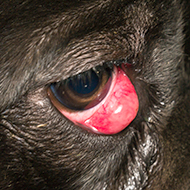
Neapolitan mastiffs, English bulldogs and Lhasa Apsos at greatest risk.
Brachycephalic dogs are seven times more likely to get cherry eye, according to new research.
The study by the Royal Veterinary College’s (RVC) VetCompass programme showed that certain breeds are significantly affected by the condition each year, namely Neapolitan mastiffs (4.9%), English bulldogs (4.8%), Lhasa Apsos (1.6%) and American cocker spaniels (1.5%).
Researchers also found that some of the most popular breeds of brachycephalic crossbreeds were also significantly affected, including the puggle (pug and beagle) (2.1%) and jug (Jack Russell terrier and pug) (1.3%).
The study is the largest of its kind, and researchers hope their findings will be used to help prospective owners make better-informed choices when purchasing a dog.
Study lead, Dr Dan O’Neill, an associate Professor in Companion Animal Epidemiology at the RVC, said: “Given that humans designed dog breeds in the first place, we all carry a heavy responsibility to constantly improve our designs to breed away from poor health for these dogs.
“The hugely increased risks of cherry eye in popular flat-faced breeds such as English Bulldogs suggests that we have some way to go before we can consider many flat-faced breeds as designed for optimal health.”
Taking its name from the pink mass that appears from the inner corner of the dog’s eye, Cherry eye is a result of the gland on the inner side of the third eyelid prolapsing, becoming red and swollen and covering part of the eye. Left untreated, the condition can lead to complications such as dry eye, conjunctivitis and eye ulceration.
Additional findings from the study include:
- one in every 500 dogs (0.20%) overall in the UK suffer from cherry eye every year
- the average age at first diagnosis of cherry eye was 0.6 years
- brachycephalic (flat-faced) dogs had 6.9 times the risk of cherry eye compared with dogs with medium skull length
- seventeen breeds showed an increased risk of cherry eye compared with crossbred dogs. The breeds with the highest risk included Neapolitan Mastiff (x 34.3), English Bulldog (x 24.1), Lhasa Apso (x 12.4), American Cocker Spaniel (x 11.6), Puggle (x 9.5), Great Dane (x 6.2), Saint Bernard (x 5.3) and Jug (x 5.2)
- sixteen breeds showed a reduced risk of cherry eye compared with crossbred dogs. The breeds with the lowest risk included German Shepherd Dog (x 0.03), West Highland White Terrier (x 0.06), English Springer Spaniel (x 0.07), Labrador Retriever (x 0.12) and Lurcher (x 0.12)
- purebred dogs had 1.4 times the risk of developing cherry eye compared with crossbred dogs
- dogs aged under one year were at the greatest risk of cherry eye (x 10.8) compared with dogs aged from two to under four years.
Commenting on the findings, BVA President Justine Shotton, said: “This important study offers strong evidence linking certain breed types with a higher predisposition to cherry eye.
"It is of particular interest to see a significant correlation between skull length and cherry eye, meaning that flat-faced breeds such as English Bulldogs are at increased risk of developing this condition. We hope the research helps better understand and address the health and welfare impacts resulting from brachycephaly.”



 The BSAVA has opened submissions for the BSAVA Clinical Research Abstracts 2026.
The BSAVA has opened submissions for the BSAVA Clinical Research Abstracts 2026.